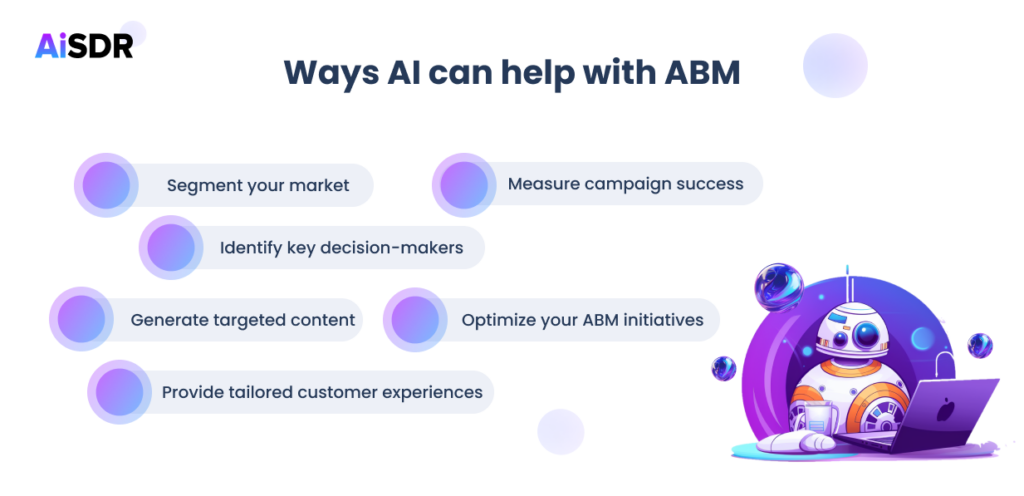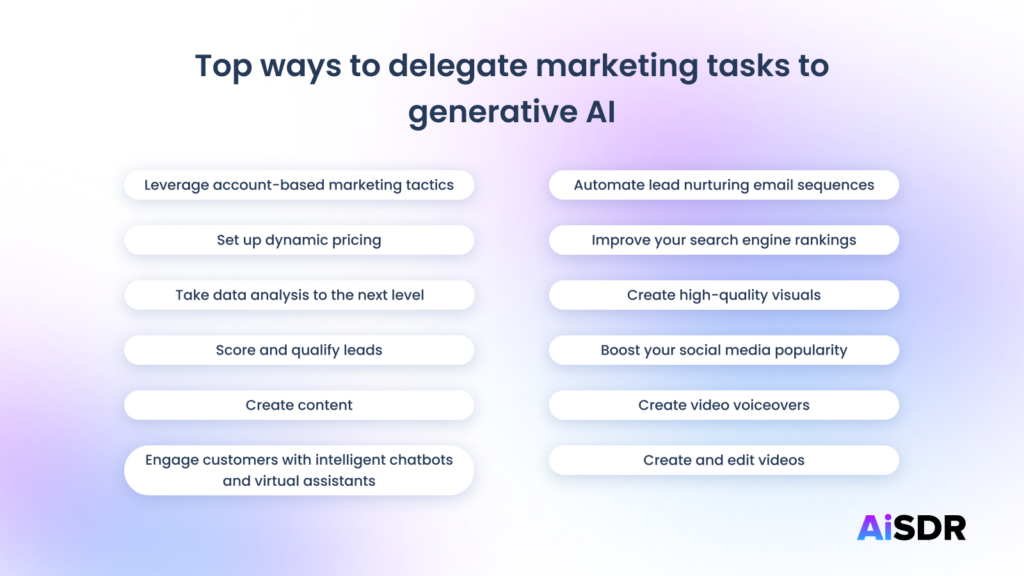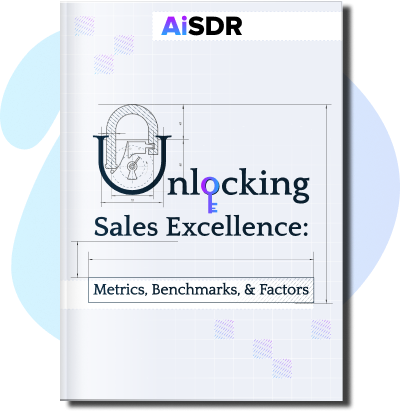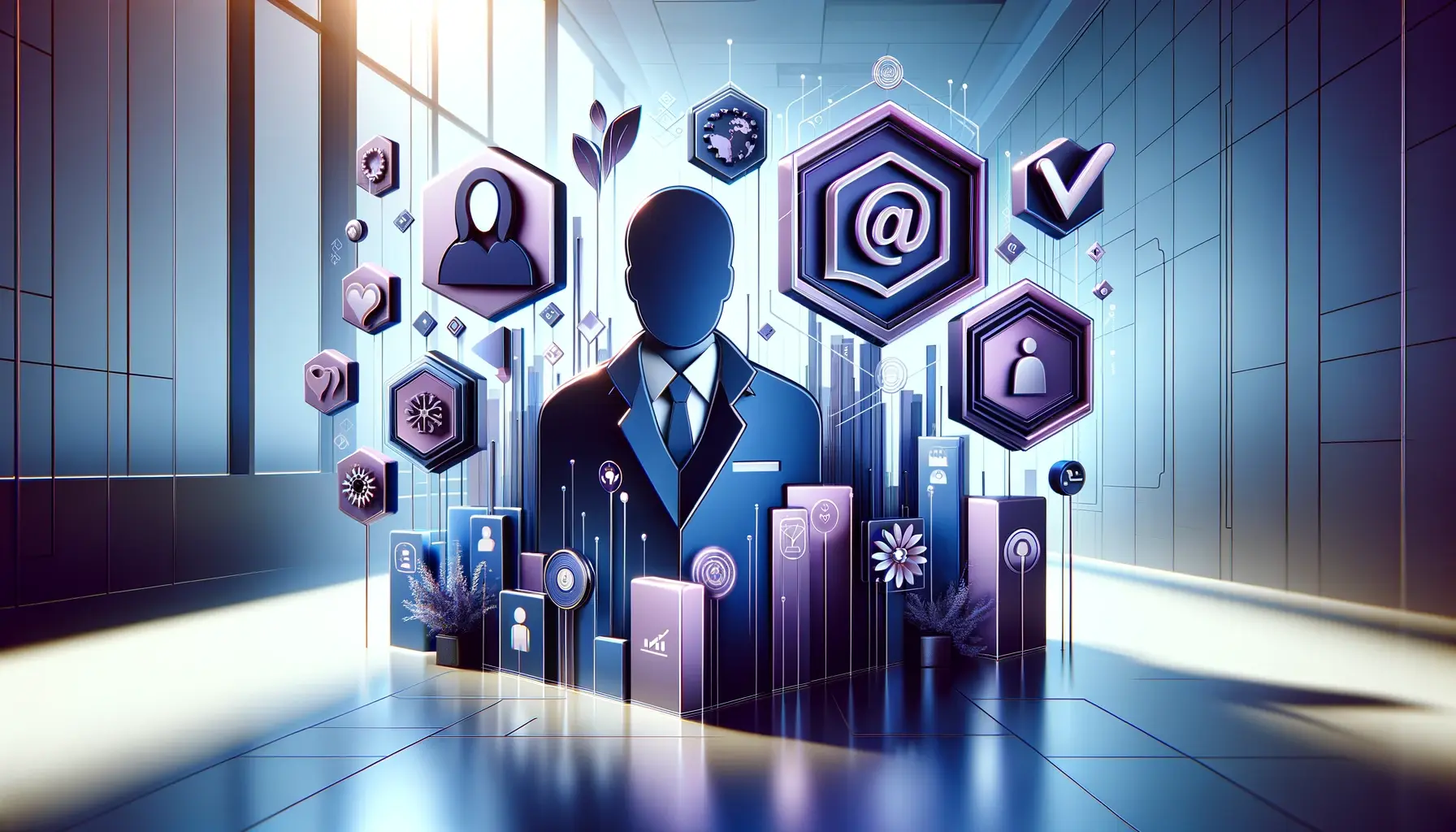Inbound Marketing Tasks You Can Delegate to Generative AI

Focus on delighting your leads with unique experiences. See which tasks you can offsource to the AI to make room for creativity
AI has been on everyone’s radar recently, and marketing is no exception. This has led to a mad scramble where new faces and seasoned marketers alike explore the abilities of generative AI in marketing. They all ask the same question: How exactly can AI technology be used to gain a marketing advantage?
In this article, we’ll explore AI for inbound marketing, which can be labor-intensive and time-consuming. We’ll show you the tasks that you can delegate to AI tools, so you can focus on big-picture thinking and value-added services.
First, let’s talk about the growing popularity of AI.
Increasing adoption of AI in business
According to the 2022 McKinsey Global Survey on AI, the adoption of AI technology has doubled since 2017. And this is more than just hype. AI has been a real boon to businesses.
Generative AI, in particular, has been hogging the spotlight for a good reason. Dubbed the next productivity frontier, the technology brings a new level of business efficiency.
“We’re seeing that business leaders, by and large, are excited by the potential of generative AI, primarily because it can drive both productivity improvements and increased customer engagement”, says Matt Jackson, global CTO of Insight.
Efforts to increase efficiency and reduce costs are particularly crucial in today’s uncertain economic environment. And generative AI’s productivity boon is expected to impact the global economy to the tune of $2.6 trillion to $4.4 trillion annually.
And AI’s era is only just beginning. In marketing, generative AI is expected to provide a productivity boost valued at 5% to 15% of total marketing spend.
Next, let’s get more specific and discuss the role of AI in marketing.
Understanding generative AI in marketing
Generative AI is a broad term used to label the types of artificial intelligence capable of producing content, images, audio, videos, and code. The technology isn’t new, but it has been creating a buzz recently because of its hyperrealistic creations.
As you can imagine, generative AI can do a lot for inbound marketing, which is often preoccupied with delivering resonant content and experiences at every touchpoint or customer interaction with the brand.
And generative AI is already delivering. In addition to producing chatbots that listen and respond to customers in human-like ways, AI has also created accurate content, simulated real humans in videos, and personalized large-scale marketing messages.
That’s the big picture, but there are many specific ways generative AI can help you with your work.
Top ways to delegate marketing tasks to generative AI
Now let’s explore how generative AI can help you work smarter, not harder. With advanced tools taking repetitive routine tasks off your hands, you and your teams will have more bandwidth for high-value strategic marketing.
Here are some of the many ways AI can help you with your marketing:
Leverage account-based marketing tactics
You can’t always rely on broad and lead-based campaigns, not when you’re trying to win over best-fit companies with high revenue potential. If you haven’t adopted account-based marketing (ABM), it’s time to catch up.
Account-centric efforts are already paying off for some B2B companies, with ABM programs accounting for 73% of their revenue. Not all marketing teams, however, have the resources to deliver personalized customer content.
That’s where AI comes in. Now you can power your account-specific marketing campaigns without needing additional resources.
You can count on AI, both predictive and generative, to help you with the following:

Segment your market
Segmentation is the secret sauce for providing personalized services to large audiences. And AI can cover the job of grouping accounts with relevant characteristics.
For instance, you can identify accounts with a high contract value based on company revenue, geography, employee count, reputational value, growth indicators (such as customer retention rate, inventory level, and operational performance), and other key data.
Identify key decision-makers
The B2B buying journey can be a long and winding road. To ensure your business is the end destination, you need to win the hearts and minds of key decision-makers.
AI can help you understand your customers’ roles in the buying process. You can then engage them accordingly.
For instance, your dialogue with the senior vice president who initiated the buying process won’t be the same as the one you’d have with the C-level executive who’s actually going to sign the check. After all, these two roles have different priorities, pain points, and strategic goals.
Generate targeted content
To tickle the fancy of your target customers, you need content and messages that speak to them. And AI can speed up the crafting of personalized ad copy, website content, emails, and other messages.
Provide tailored customer experiences
The needs and requirements of your customers change as they move from one touchpoint of the buyer’s journey to another. With the help of AI, you can cook up sophisticated strategies designed to address shifting customer sentiments and deliver tailored experiences.
Leave AI to do its nifty job of learning from past interactions, anticipating future needs, predicting behavior, and crafting resonant messages.
Measure campaign success
You’re putting in the time and effort, but is your ABM campaign really delivering results? AI can help you measure success by tracking customer engagement, sales cycle length, average deal value, and win rates.
Optimize your ABM initiatives
AI can track and analyze customer behavior in real time while suggesting the best content and channels to use. You get optimized campaigns that pave the way for higher engagement rates and ROI.
With AI assisting you, providing personalized attention to countless accounts is now possible even as you maintain lean marketing teams.
Automate lead nurturing email sequences
Don’t leave your warm leads high and dry. Keep the conversation going with follow-up emails that speak to the prospect in meaningful ways.
The moment a potential customer interacts with your brand, an AI tool can activate a relevant lead sequence. And it’s not just going to send out generic messages. Generative AI analyzes customer data and past interactions before using the insights to create hyper-personalized messages.
For instance, AI can activate lead sequences whenever prospects abandon items in their carts, subscribe to a newsletter, download gated content, and complete a lead generation form. The automated tool then comes up with a series of emails, personalizing each message so it sounds like a conversation.
Generative AI is equipped to counter objections, figure out the right timing for sending messages, and increase the chances of recipients actually opening and acting on the emails.
Engage customers with intelligent chatbots and virtual assistants
Thanks to AI, you can now have chatbots and virtual assistants that run conversations like humans do. You get assistants that never sleep nor require coffee breaks.
AI-powered chatbots are far more intelligent than rule-based ones. Rule-based chatbots can only offer an interactive FAQ where they provide scripted answers to commonly asked questions.
AI-powered chatbots, on the other hand, leverage machine learning and natural language processing (NLP) to understand questions and provide out-of-script answers. They learn from every interaction and become better at handling complex queries over time.
When it comes to intelligent interactions, virtual assistants take the cake. They don’t just answer questions, but they also perform tasks for customers thanks to integrations with other systems. AiSDR, for instance, can be connected to scheduling apps like Calendly to book meetings between prospects and your sales representatives.
You can rely on intelligent chatbots and virtual assistants to answer your customers’ queries 24/7, provide recommendations, assist buyers with checkout, address issues, and keep customers engaged until a live agent is available.
With trusty chatbots and virtual assistants, live agents won’t be as overburdened and can have more bandwidth to provide value-added services.
Score and qualify leads
Inbound leads are prospects who have already shown interest in your offerings. But even then, not all of them are worth your attention.
You need to filter out those most likely to become paying customers. Otherwise, you’d be spreading your teams too thin and seeing minimal results.
Traditional lead qualification and scoring involve manually sifting through leads and assigning them scores and prioritization levels. This process requires too much laborious work and subjective judgment, which makes it both costly and unreliable.
AI-based lead qualification, on the other hand, brings quicker results and captures opportunities at a faster rate. You also free up valuable resources, which means you don’t only earn more revenue but also save significant costs.
How do you effectively implement AI lead scoring and qualification? Here are some quick tips:
Pick the right AI tool
Not all AI tools are equal. You need AI software designed specifically to improve your marketing processes.
AiSDR does a particularly great job of analyzing large amounts of data and weeding out leads that aren’t worth your time. Your marketing and sales teams can devote their attention to promising leads, greatly increasing efficiency and conversion rates.
And because the AiSDR tool continuously learns from incoming data, your lead scoring and prioritization processes will improve over time.
Integrate AI with your existing systems
Integrating your chosen AI with your existing software further accelerates processes. For instance, linking it up with your customer relationship management (CRM) system allows it to use data you’ve already collected.
Before long, you’ll be watching your pipeline grow with a continuous stream of qualified leads.
Take data analysis to the next level
Generative AI covers the usual work of predictive models: analyzing large data sets at record speed, identifying patterns, inferring meaningful insights, forecasting market trends, improving decision-making, and optimizing marketing campaigns.
But here’s the kicker.
Advanced AI tools like AiSDR also generate new data points, train unsupervised, make sense of data, and draw conclusions without requiring human input.
This means you get a system that learns as it works. For instance, generative AI becomes more adept at handling queries the more it interacts with customers – all without needing constant human input.
Set up dynamic pricing
The pricing of goods and services can fluctuate alongside consumer demand and market conditions. With so many factors and pricing combinations, implementing dynamic pricing can be time-consuming and complex.
But then again, you can turn to generative AI for help.
Come up with the best pricing strategy
It’s easy to bite into simplified pricing strategies, such as matching the lowest market price. But this will have you locked in a race to the bottom with shrinking profit margins.
AI can consider factors like price elasticity and stock levels to determine optimal prices.
Personalize price offers
AI can adjust pricing to incentivize customer behavior and purchase history. It can also offer the best prices based on customer demographics, factoring in location, status, and purchasing power.
With the aid of AI, you can tailor pricing and promotions to maximize conversion and capture new revenue sources.
Create content
There’s no need to stare at a blank screen when generative AI is here to save the day. With just a few prompts, AI can create an outline or generate ideas to help you get started. On top of that, generative AI goes as far as personalizing your content or crafting emails for specific sales personas.
Here are some ways generative AI can help you with content creation:
Automated content generation
If you regularly need content created, you might as well get a reliable AI tool to do the job. It’s akin to having a tireless writer creating a steady stream of content for you.
Note, however, that you will still have to monitor the end product. AI tools work with limited input or information sources, which means they don’t always compile reliable and factual content. Stack Overflow, a popular question-and-answer platform for programmers, had to ban content generated by ChatGPT because of inaccuracies they’ve spotted. Even worse, a couple of American lawyers found themselves in legal hot water for referencing court cases that didn’t actually exist.
So while you can count on the tool to churn out contextually relevant articles, blog posts, social media captions, and email newsletters, you must always make sure you perform a bit of due diligence and quality control on AI-generated results.
Personalized content
AI can understand language semantics, which enables it to create content within your brand voice and targeted marketing campaign.
In addition, AI is able to work with large amounts of data, allowing you to send personalized messages to customers en masse. It can even manage email follow-ups and chat responses.
With generative AI doing the job, you can produce and send out large volumes of personalized messages with reliable quality and consistency.
Improve your search engine rankings
Generative AI boosts your search engine rankings by analyzing user intent and crafting content that addresses specific needs and queries. This translates to more brownie points for SEO in terms of relevance and value. Plus, it suggests improvements, adds keywords to content, improves readability, and entices engagement.
With AI doing most of the work, marketers won’t have to spend as much time on SEO and can focus more on content quality.
Create high-quality visuals
You no longer have to be an artist to create stunning visuals. With generative AI, you can now craft unique images and 3D models using only text prompts.
You can whip up impressive social media posts, ad copy, and website layouts from scratch, even if you don’t have highly developed graphic design abilities.
Boost your social media popularity
Keep an ear out for what customers are saying about your brand. This means tracking social media posts, analyzing conversations, recognizing trends, and identifying prevailing customer sentiments.
And, of course, you can rely on AI to do the listening for you.
You’ll get insights that help you better understand what your customers like (and don’t like), gauge your brand reputation, and craft effective messaging. You can even use AI to come up with user reviews and testimonials that offer social proof or evidence of your brand’s popularity and usability.
Create video voiceovers
You no longer have to hire voiceover talent or spend hours trying to get the recording right. With generative AI, you can convert text into natural-sounding speech in minutes.
And you can create it in your chosen voice style and language. AI-generated voiceovers work great with videos, presentations, and audio ads, giving them a professional touch that’s bound to impress.
Create and edit videos
Video editing is another time-consuming task that AI can handle for you. AI tools take much less time to review raw footage, pick out key moments, put together relevant clips, create seamless transitions, and spice the video up with effects.
You can even use AI to create videos from scratch. Just create pre-designed templates, images, animations, text, audio, and voila! You’ve got a professional-looking video. Add your unique brand flavors and campaign themes to generate a winning video for your AI-powered inbound marketing.
Bringing in a much-needed human touch
Yes, even AI this intelligent still requires a human touch. It’s not your replacement. It’s but a mere tool designed to make your job easier.
Here’s where AI helpers could use human oversight:
- Set up quality control measures to ensure the AI tool’s creations match your brand’s voice and values.
- Make the most out of the AI’s capabilities by mastering the fundamental principles of creating tasks or prompts. After all, AI can still struggle with complex concepts or business requirements, requiring human input to get past obstacles.
- Bank on human creativity to bring fresh ideas and unique perspectives to content creation.
- Ensure the AI subscribes to strict ethical standards to prevent biased or misleading content.
With a collaborative approach, marketers and AI tools can effectively work together to create enhanced outcomes.

Conclusion
Contrary to what the rumor mill has been spewing, generative AI will not replace you. It still needs human input to reach its full potential. But this technology could become your productivity partner that speeds up the rate at which you churn out content, ad copy, marketing messages, and data analyses.
And by delegating many repetitive tasks to the AI tool, you’ll have more bandwidth for creating a high-level strategy, making effective decisions, and forging fruitful relationships.
Book a demo to experience how AiSDR can fit into your inbound marketing strategy.
FAQ
What is inbound marketing?
Inbound marketing is a strategic approach to digital marketing that aims to attract customers with content that resonates and builds a foundation for a long-term relationship.
How can AI be used in marketing?
AI can analyze customer data, make predictions that enable smart decision-making, create high-quality content, and improve customer experiences.
How can generative AI impact the field of marketing?
Generative AI can significantly boost productivity and give marketers more bandwidth for value-added services.
How does AI affect sales and marketing?
AI allows sales and marketing teams to automate repetitive tasks and connect with customers at scale. Marketing and sales optimization translates to greater efficiency and lower costs.











